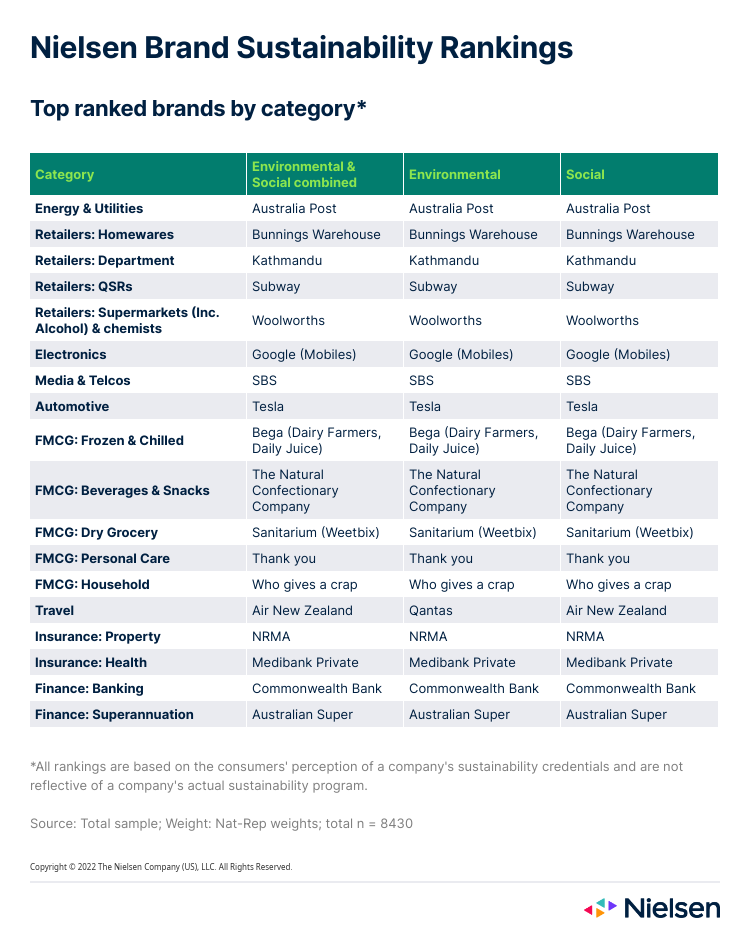Find out who tops Nielsen’s Brand Sustainability Rankings for 2022
across 18 different industry categories*
Sydney, 25 November 2022 – Nielsen today released its Brand Sustainability Rankings for 2022 – a survey of 8,430 Australian consumers to find out how they rank the sustainability credentials of 247 core brands across 18 categories, including media, travel, retail, and banking.
Each of the 18 categories was assigned a Social Ranking, Environmental Ranking, and an Overall Ranking (a combination of Social and Environmental Rankings). These Rankings reveal consumer brand perceptions across key sustainability metrics, rather than what brands are actually doing in the marketplace*.
Bunnings Warehouse was number one in the Homewares Retailer category across all three rankings. The Commonwealth Bank did likewise, taking out top spot in Social, Environmental, and Overall Ranking for the Banking category. SBS also scooped the pool across all three rankings for the Media and Telco category.
Qantas was number one in the Environmental Rankings for Travel, while Air New Zealand topped the Travel Category for Social Rankings and Overall Rankings (Environmental and Social Rankings combined).

Nielsen’s Brand Sustainability Rankings are a key component of its recently released Brand Sustainability Report, compiled with support from Dentsu, AANA, and EDGE Environment.
The 18 broad product categories in the rankings were selected based on their relevance to the Australian consumer market, including market share, prominence, and information from Nielsen’s Ad Intel and Consumer & Media View (CMV).
To maintain independence, no company was involved in the selection process and none had the option of being excluded.
To help consumers associate the relevant brand with the relevant organisation, where the company name is not directly associated with a brand, both the company name and brand name were shown together (e.g. Unilever’s brands were shown as Unilever – Ben & Jerry’s, Streets in the Frozen & Chilled category).
FIND OUT MORE ABOUT NIELSEN’S BRAND SUSTAINABILITY RANKINGS AND REPORT
NOTE: *All rankings are based on the consumers’ perception of a company’s sustainability credentials and are not reflective of a company’s actual sustainability program. See below for more information and for the ranking methodology.
#ENDS#
About Nielsen’s Brand Sustainability Report
Categories and brands
Consumers were randomly assigned two categories to assess separately. For each category, they were asked to rank the environmental and social factors in order of importance to that specific category, with factors presented in random order. Subsequently, they were then asked to rate each of the brands against the top three environmental and social factors (brands were also presented in random order). These scores were then combined to form the rankings.
Brand ranking methodology
Both environmental and social sustainability were important areas for consideration in this research due to the macro yet nuanced nature of sustainability to consumers.
As such it’s not always a level playing field across all categories. For example, it’s more challenging for service-based categories to drive notable positive environmental change compared to categories that sell physical products which is why Social sustainability needs to be a key consideration.
While consumers increasingly view their consumption habits through a sustainability lens, their perspectives may shift depending on the situation. As important as the topic of sustainability is, it’s still one of several factors in a consumer’s decision-making process.
Equally it is key that brands not only consider their behaviour but the behaviour of other brands in the category as there is both a positive and negative halo effect across brands. As a result, it is truly the time for category thinking in regard to sustainability
The process for determining a brand’s sustainability ranking* followed four broad steps.
Step 1.
Consumers were presented with a category and asked to rank various sustainability statements in order of importance when considering that specific category. This ranking allowed Nielsen to create weights for each statement, based on relevance.
Step 2.
Consumers were asked to score all brands within a category on their perceived delivery against their top three ranked statements.
Step 3.
Advanced statistical techniques were used to combine the statement weighting with the brand score for all brands within the category.
Step 4.
All data was combined to produce a ranking across categories.
Nielsen Brand Sustainability Rankings
Consumers rated brands across environmental and social sustainability factors, which were calculated in combination to provide an overall brand ranking.
These scores were then combined to form the rankings. It should be noted that a holistic view should be taken when assessing these rankings, in that differences between two brands ranked closely together (e.g. less than five places) should not be taken as a statistical difference. However, a brand ranked approximately 20 places better than its competitors would indicate a much better market perception.
About Nielsen
Nielsen shapes the world’s media and content as a global leader in audience measurement, data and analytics. Through our understanding of people and their behaviours across all channels and platforms, we empower our clients with independent and actionable intelligence so they can connect and engage with their audiences – now and into the future. Nielsen operates around the world in more than 55 countries.
Learn more at www.nielsen.com and connect with us on social media (Twitter, LinkedIn, Facebook and Instagram).
Media Contact
Dan Chapman
Associate Director, Marketing & Communications,
Pacific, Nielsen
dan.chapman@nielsen.com
+61 404 088 462
